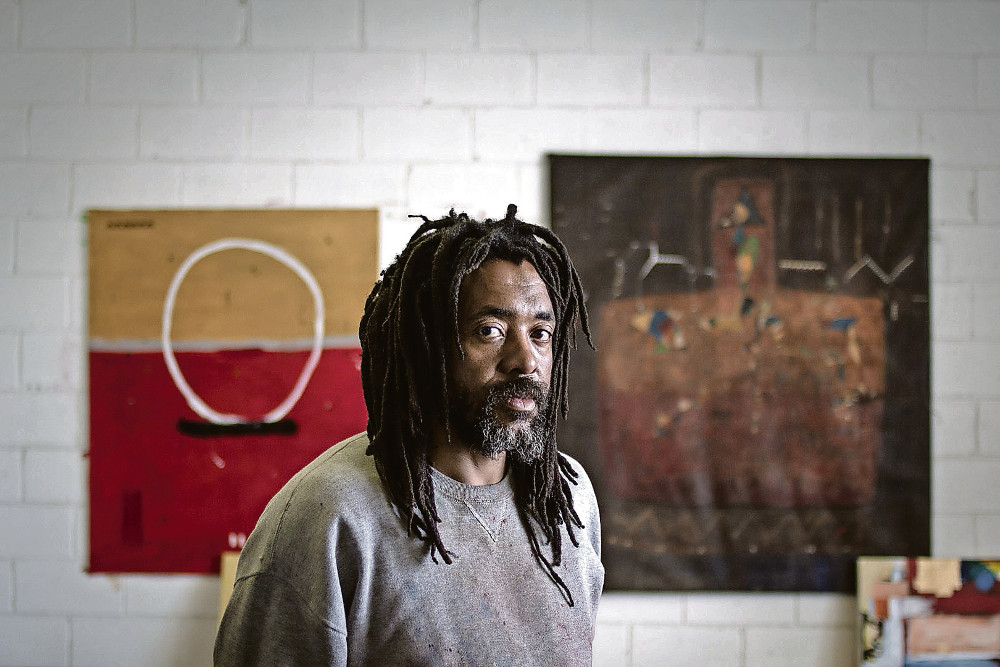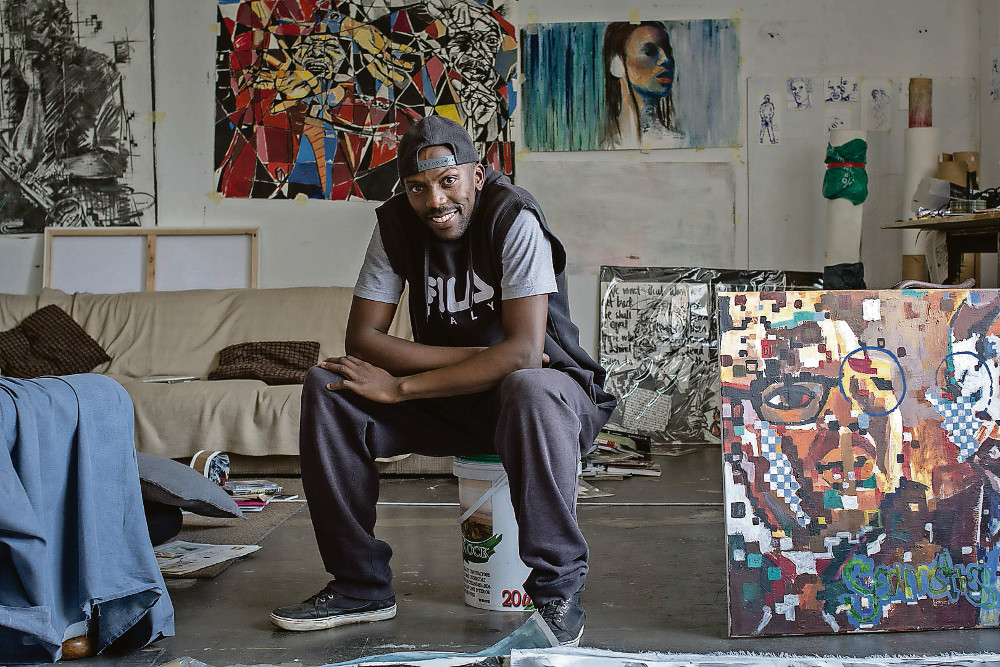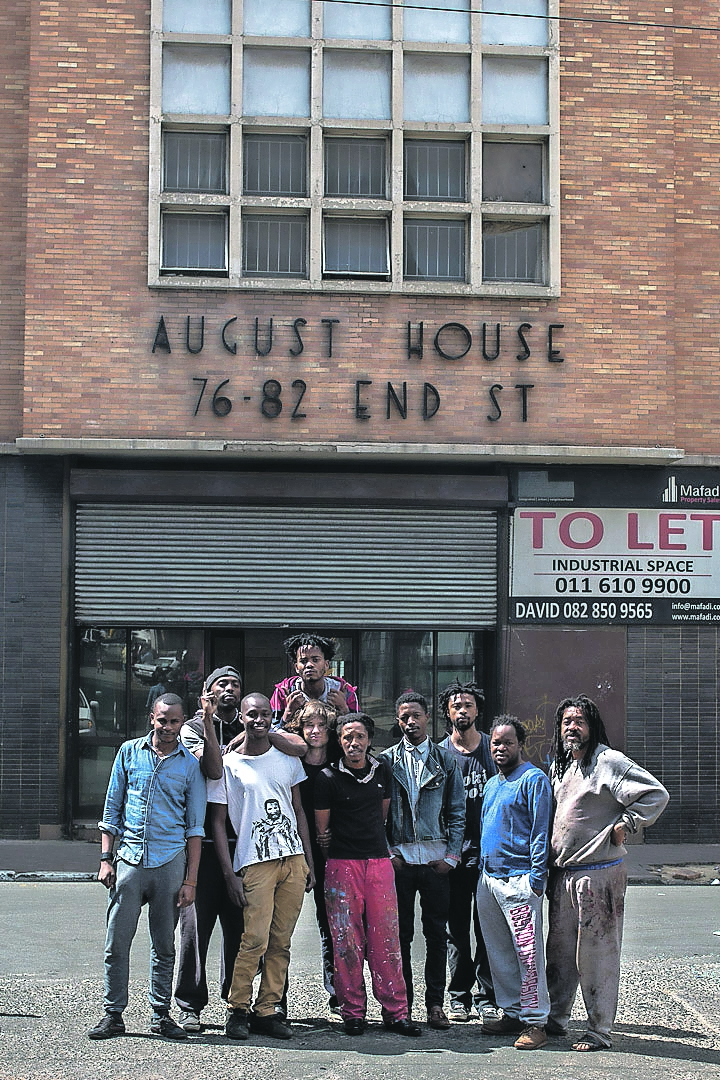Some of the residents of the relaunched August House gather in artist Samson Mnisi's studio.
“Don’t hold the paper like that,” Layziehound Coka tells his landlord, David Mayers, who has come to collect rent in the form of art. Leafing through a pile of Coka’s work, Mayers — who has recently purchased August House, an artist’s residency in Doornfontein, Johannesburg, where Coka and other artists have studios and/or living space — swiftly adjusts his grip on the artist’s work.
“When you hold art, you have to pinch the opposite corners of each side, like you’re holding a cigarette. Otherwise you’ll break the fibre of the paper,” the gangly artist tells the young property developer, who is giving me a tour of the relaunched August House.
The building was renowned for once having hosted the city’s artistic elite, although few of the artists were faring well financially. Amid a sea of half-used paint tubes and layers of sketches on paper and canvas, KwaZulu-Natal- born Coka finds his “rent” and carefully lays out two cubist-style renditions of jazz musicians for Mayers.
Walking me around the shiplike structure, as construction workers put the final touches to the building before more artists move in, Mayers talks passionately about art and his intention to restore the Art Deco building to its former glory. Weeks later, at the start of spring, the building is alive with movement and banter, and a ripe scent of sage wafts through the second floor. There has been a rush of artists into the space over the past month and Layzie, as his peers call him, is creating art in his studio.
“If you can’t afford to pay rent, artists give two of their paintings. But I haven’t had to do that since my first month in August House in June,” says Coka in his wise-beyond-his-years way about going from being cash-strapped to showing his work at art fairs and making enough money to pay rent. “I wasn’t earning any money at the time I moved in. So as per the contract, we had an agreement that they’d take two works a month. I wasn’t very comfortable with it but beggars can’t be choosers.
I think the contract was fair seeing that the landlords hadn’t seen my work out there and I’m not established, but they were able to trust that my standard of work is good.” Unlike my first visit to August House in August, this time there’s a stream of artists flowing in and out of Coka’s studio. A paint-stained, gold-toothed Samson Mnisi — celebrated for his minimalist metallic paintings who has a studio across the way — makes an appearance, and so does his work. Fellow resident Senzo Shabangu’s brightly coloured painting hangs on Coka’s studio wall, it’s curved lines contrasting with Layzie’s angular constructions.

Samson Mnisi.
As an outsider, August House today looks like an idyllic artist community and possibly the closest thing to what it might have resembled when it was first conceived by Bie Venter in the mid-2000s. In an interview with the Mail & Guardian in 2013, Venter said the idea was to create a community of like-minded, creative, forward-thinking people living and working in an affordable, spacious, semi-industrial location. August House was opened in 2006 by Venter and her business partner Maria Svane as more than just a collection of apartments and artists’ studios — art thrived there.
And in its glory years it housed the likes of such successful artists as Kudzanai Chiurai and Nicholas Hlobo, curator Gabi Ngcobo and art history lecturer Nontobeko Ntombela. A lot changed in the building on End Street since those days. Not its Art Deco structure, but rather how Venter’s vision of August House was almost diminished.
“There were rumours going around that the previous owners [a small consortium led by Molly Jayes] were looking to sell and that the building lent itself well to these low-income residential conversions. Once those rumours went around, most of the guys left,” says Mayers, who learnt about the building last year from Nelson Makamo, an established painter who stayed on at August House despite the mass exodus of artists from the end of 2013.
Adrian Myers, who managed the building from 2014, says August House was put on the market at the time, but because the City of Johannesburg overvalued it selling it became impossible. “When notification happened that the building was on the market, I was dealing with other shit, which was whether I was going to get a kidney transplant or not. Basically whether I was going to stay alive or not,” says artist Diane Victor, who, with Nelson Makamo, has been in the building the longest.
Victor, who splits her time between Pretoria and Johannesburg, uses the Doornfontein studio to make drawings. “So at the time my priorities in finding another studio was fairly low on my importance list. And I actually really enjoyed August House as a space, as I think most of the others did. I think they wouldn’t have left if they weren’t under threat of having very short notice of trying to find a place.”

Layziehound Coka.
Luckily for Victor, Makamo and the future of August House, Mayers approached the previous landlord and officially took ownership of August House in May along with his minority partner Alon Kirkel. And unlike the rumours of converting the large studio spaces into tiny apartments, the two had no plans to change it.
“Having spoken to the likes of Diane, Nelson and Bie Venter, who really pioneered the whole studio space environment, I wanted to turn it back into what it was,” says Mayers. “The beauty of August House has always been the raw essence of its nothingness.”
Later, with the clothing factory on the first floor moving out to Troyeville, Mayers converted it into more studio space, turned the second floor into smaller studios for up-and-coming artists, but the top floor retains its larger studios for the more established artists. Mayers was then able to invite some past August House tenants such as Mary Sibanda and Lawrence Lemaoana to return, and bring on board younger artists such as Coka as well as veteran artists such as Sam Nhlengethwa.
“We’ll never make money from August House,” Mayers told the M&G. “Even if someone came in and offered me 20% to 30% more than I paid for it, there’s just no way that I’d sell it.” The art collector and property developer says he is grateful that August House is once again a working space for what he believes to be “South Africa’s top contemporary artists. I just love to walk into the studios to watch the evolution of the artists. It has been hugely fulfilling.”
Mayers says the building is full, but that hasn’t stopped more artists from pouring into the space either to collaborate with the residents or to share studios. “I’m very glad I stayed on. Now that the factory has moved out, I think it’s solely an artists’ building,” says Victor. “Alon has some very nice ideas in terms of turning it into a more interactive art centre. The owners are working far more closely with the younger artists, trying to be supportive and helping them with their careers. So it becomes, I’m hoping, more of an artist community than a building that lets space out to anyone.”

As part of Art Week Joburg, August House will host open studios, a pop-up gallery and sales of artists’ works on Sunday September 13. For more information, call 083 406 1808 or visit artweek.co.za